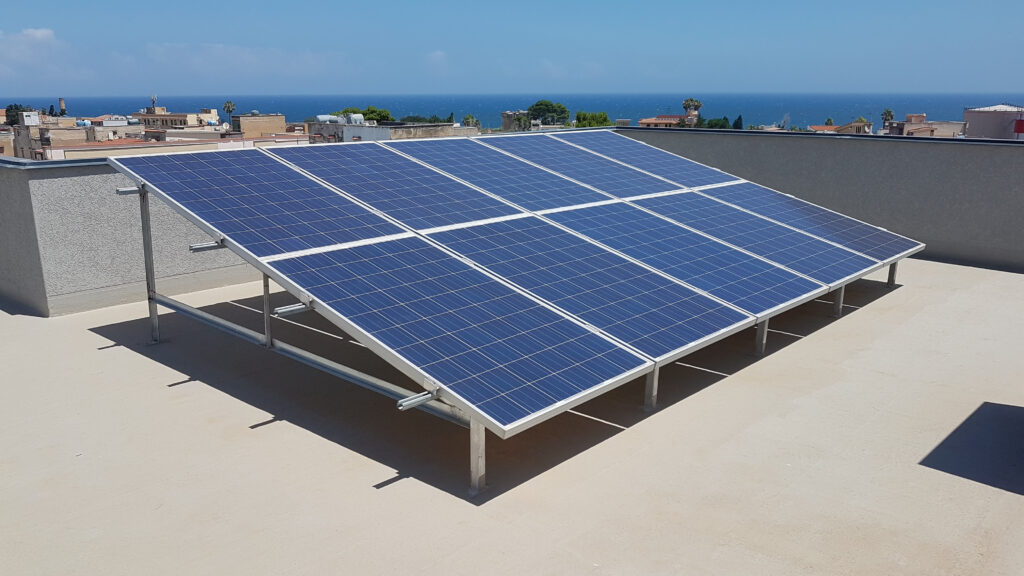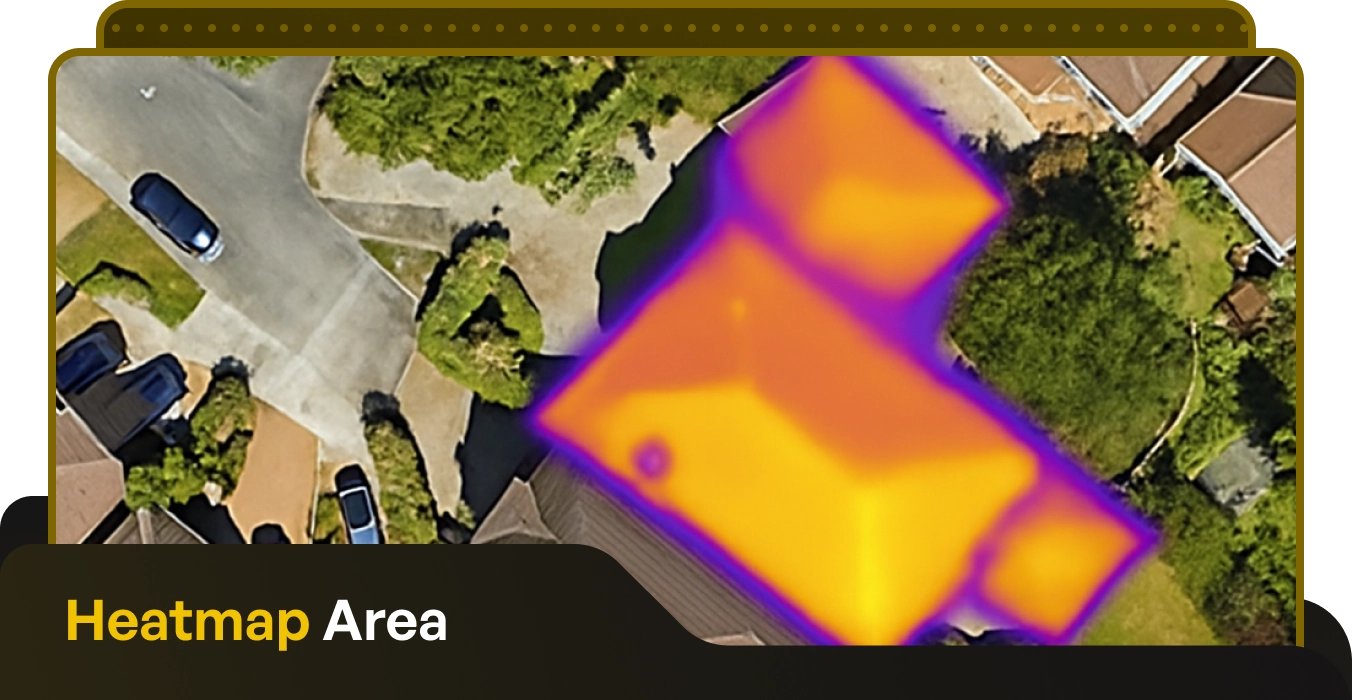Solar Panels for Flat Roofs

Written by: Briain Kelly
Published: July 14, 2025
Last updated: October 8, 2025
Reading time: 4 mins
Solar panels are highly versatile additions to any building, regardless of the roof type on which they are being installed.
Flat roofed buildings can benefit immensely from installing solar panels to reduce their energy bills.
Our guide will take you through the technical aspects of solar PV systems for flat roofs and where they differ from sloped roof solar installations.
Can solar panels be installed on flat roofs?
Solar panels can be installed on any flat roofed building, whether it is a home, apartment building, business, or other property type.
There are multiple challenges and technical aspects which will differentiate a solar PV system on a flat roof, which should be taken into account during the design stage.
The following factors will determine the utility, difficulty, and price of any solar PV system for a flat roof building.
- Optimal Angle: Taking weather and roof surface into account
- Optimal Direction: The best direction for solar panels to face.
- Shading: Ensure there is no shading on your solar panels.
- Mounting System: What mounting system is being used for solar panels on your roof.
- Roof Structure: What is the surface type of the roof, and how much weight can it take?
- Maintenance Requirements: Will the PV panels need to be maintained and cleaned?
Angling Solar Panels
For solar panels to have the best performance, it is optimal that they be installed at an angle in the region of 30° – 45° to get the most sunlight.
There are a number of reasons why this might not be done with solar panels on a flat roof, namely, safety and space.
Solar panels on a flat roof are more often installed at an angle of 10° – 15 degrees° since they are less vulnerable to the wind and can be more easily kept in place.
In addition, solar panels angled at 30° – 45° on a flat roof will cast a shadow when they are in the sun.
This means that rows of solar panels will need to be placed further apart in order to avoid shading each other, taking up more roof space with fewer panels.
While this angle is best for each panel, your solar PV system as a whole could lose out because you won’t be able to include as many panels.
Picking the Right Direction for Solar Panels
One advantage of placing solar panels on a flat roof is that you are able to control the direction the panels face.
With a flat-roofed building, it is easier to ensure that your solar panels are oriented to the south to get the greatest amount of sunlight throughout the day.
This can also be used to avoid shading. If a south-facing solar panel would be in shade most of the day, it could be oriented to the east or west instead to avoid this.
Bifacial Solar Panel Gains
Flat roofs can take advantage of the growing number of solar panels with bifacial solar cells and a dual glass frame.
Bifacial solar panels can absorb sunlight from both sides of the panel, increasing the amount of power they generate.
On flat roofs, solar panels may have a greater ability to take advantage of reflected sunlight depending on the angle they are installed at, and the surface of the roof.
A reflective material installed on the roof below a solar panel can help to bounce back light which has passed through the panel, or is coming from another direction.
Since a flat roof is less visible from the ground than a sloped roof, this won’t cause the same level of visual disturbance.
However, this may cause issues if it could potentially cause glint or glare that is deemed hazardous. This is most likely to occur if the property is located within one of 33 Solar Safeguarding Zones (SSZ) in the vicinity of airports, helipads, and airfields.
Consult with your local authority if there is ever any uncertainty if an element of a solar PV system is permitted.
Solar Panel Mounting Systems
There are different mounting systems for solar panels on flat roofs, which may vary based on how they are angled and the nature of the roof surface.
Mounting systems for flat roof solar panels can usually be divided into two broad categories.
The solar panels and mounting frame are held down by ballast rather than being affixed to the roof. This is the most common method for panels installed at a 10° – 15° angle of inclination. The greater the elevation of the solar panels, the more ballast that will be needed.
These triangular frames can give your solar panels a greater amount of elevation to catch the sun. They typically have to be screwed into the roof itself to keep them in place.

Tilt frames are more common for roofs which have a very slight inclination, but far less than a pitched or sloped roof.
Where a solar panel mounting system is affixed to the roof, it must not penetrate the watertight seal created by the roof.
Rood Surface Suitability
Flat-roofed buildings can differ from each other in many ways, and there are multiple factors about the roof which must be surveyed before installing any solar panels.
Some of the factors that can affect the suitability of a flat roof for solar panels include:
- Surface Type: A flat roof surface could be made of anything from roof shingles or tiles, metal sheeting, or tar and gravel.
- Drainage: Water pooling can be a serious hazard for the electrical systems of solar panels on a flat roof if the water is not draining properly.
- Weight: Installing solar panels on a roof can add significant weight, particularly if mounted with a ballast system. Ensure the roof can take the added weight before proceeding.
Maintenance Requirements for Solar Panels
There is usually very little maintenance needed for solar panels. The only regular work they need is to keep them clean and free from obstructions.
On a pitched roof rain and gravity together will do the job to keep your panels clean and free of any debris.
However, on a flat roof, particularly if the modules are at a low angle and installed close together, they may need more frequent cleaning.
Pros and Cons of Flat Roof Solar Panels
Advantages
Easier to Install: With freestanding mounting systems in most cases, flat-roofed solar panels can be quicker and easier to install than on a tiled pitched roof.
Simple to Upgrade: Those mounting systems also make it easy to swap out panels for new and improved modules if one is damaged, or if upgrading to more efficient panels.
Potentially Lower Costs: The simpler installation process can significantly reduce the cost of solar panels on a flat roof compared to the same number on a pitched roof.
Disadvantages
Less Power per Module: A solar module installed on a flat roof will likely deliver less power than on a pitched roof due to an inferior angle of tilt.
Take up More Space per kWp: Flat roof solar systems will require more space per kWp capacity, either due to their less optimal angle or the need for greater spacing.
Greater Weight on Roof: Flat roof ballast mounting systems have a far greater weight than pitched roof systems.
Leakage Risks: The weight of the system may create a risk of water leaks if they exacerbate a water pooling problem.
More Regular Cleaning: Solar panels mounted on a flat roof will likely need to be cleaned more frequently than on a pitched roof.
FAQs
Homes and businesses can install as many solar panels as they like on their roof as long as they meet some building restrictions.
There must be a gap of at least 200mm between any solar modules and the parapet of a flat-roofed building.
Planning permission will likely not be required to install solar panels on any flat-roofed building, unless it is a protected building or in a conservation area.
Solar Panels for Flat Roofs
Published: July 14, 2025
Last updated: October 8, 2025

Written by: Briain Kelly
Reading time: 4mins
Solar panels are highly versatile additions to any building, regardless of the roof type on which they are being installed.
Flat roofed buildings can benefit immensely from installing solar panels to reduce their energy bills.
Our guide will take you through the technical aspects of solar PV systems for flat roofs and where they differ from sloped roof solar installations.
Can solar panels be installed on flat roofs?
Solar panels can be installed on any flat roofed building, whether it is a home, apartment building, business, or other property type.
There are multiple challenges and technical aspects which will differentiate a solar PV system on a flat roof, which should be taken into account during the design stage.
The following factors will determine the utility, difficulty, and price of any solar PV system for a flat roof building.
- Optimal Angle: Taking weather and roof surface into account
- Optimal Direction: The best direction for solar panels to face.
- Shading: Ensure there is no shading on your solar panels.
- Mounting System: What mounting system is being used for solar panels on your roof.
- Roof Structure: What is the surface type of the roof, and how much weight can it take?
- Maintenance Requirements: Will the PV panels need to be maintained and cleaned?
Angling Solar Panels
For solar panels to have the best performance, it is optimal that they be installed at an angle in the region of 30° – 45° to get the most sunlight.
There are a number of reasons why this might not be done with solar panels on a flat roof, namely, safety and space.
Solar panels on a flat roof are more often installed at an angle of 10° – 15 degrees° since they are less vulnerable to the wind and can be more easily kept in place.
In addition, solar panels angled at 30° – 45° on a flat roof will cast a shadow when they are in the sun.
This means that rows of solar panels will need to be placed further apart in order to avoid shading each other, taking up more roof space with fewer panels.
While this angle is best for each panel, your solar PV system as a whole could lose out because you won’t be able to include as many panels.
Picking the Right Direction for Solar Panels
One advantage of placing solar panels on a flat roof is that you are able to control the direction the panels face.
With a flat-roofed building, it is easier to ensure that your solar panels are oriented to the south to get the greatest amount of sunlight throughout the day.
This can also be used to avoid shading. If a south-facing solar panel would be in shade most of the day, it could be oriented to the east or west instead to avoid this.
Bifacial Solar Panel Gains
Flat roofs can take advantage of the growing number of solar panels with bifacial solar cells and a dual glass frame.
Bifacial solar panels can absorb sunlight from both sides of the panel, increasing the amount of power they generate.
On flat roofs, solar panels may have a greater ability to take advantage of reflected sunlight depending on the angle they are installed at, and the surface of the roof.
A reflective material installed on the roof below a solar panel can help to bounce back light which has passed through the panel, or is coming from another direction.
Since a flat roof is less visible from the ground than a sloped roof, this won’t cause the same level of visual disturbance.
However, this may cause issues if it could potentially cause glint or glare that is deemed hazardous. This is most likely to occur if the property is located within one of 33 Solar Safeguarding Zones (SSZ) in the vicinity of airports, helipads, and airfields.
Consult with your local authority if there is ever any uncertainty if an element of a solar PV system is permitted.
Solar Panel Mounting Systems
There are different mounting systems for solar panels on flat roofs, which may vary based on how they are angled and the nature of the roof surface.
Mounting systems for flat roof solar panels can usually be divided into two broad categories.
The solar panels and mounting frame are held down by ballast rather than being affixed to the roof. This is the most common method for panels installed at a 10° – 15° angle of inclination. The greater the elevation of the solar panels, the more ballast that will be needed.
These triangular frames can give your solar panels a greater amount of elevation to catch the sun. They typically have to be screwed into the roof itself to keep them in place.

Tilt frames are more common for roofs which have a very slight inclination, but far less than a pitched or sloped roof.
Where a solar panel mounting system is affixed to the roof, it must not penetrate the watertight seal created by the roof.
Rood Surface Suitability
Flat-roofed buildings can differ from each other in many ways, and there are multiple factors about the roof which must be surveyed before installing any solar panels.
Some of the factors that can affect the suitability of a flat roof for solar panels include:
- Surface Type: A flat roof surface could be made of anything from roof shingles or tiles, metal sheeting, or tar and gravel.
- Drainage: Water pooling can be a serious hazard for the electrical systems of solar panels on a flat roof if the water is not draining properly.
- Weight: Installing solar panels on a roof can add significant weight, particularly if mounted with a ballast system. Ensure the roof can take the added weight before proceeding.
Maintenance Requirements for Solar Panels
There is usually very little maintenance needed for solar panels. The only regular work they need is to keep them clean and free from obstructions.
On a pitched roof rain and gravity together will do the job to keep your panels clean and free of any debris.
However, on a flat roof, particularly if the modules are at a low angle and installed close together, they may need more frequent cleaning.
Pros and Cons of Flat Roof Solar Panels
Advantages
Easier to Install: With freestanding mounting systems in most cases, flat-roofed solar panels can be quicker and easier to install than on a tiled pitched roof.
Simple to Upgrade: Those mounting systems also make it easy to swap out panels for new and improved modules if one is damaged, or if upgrading to more efficient panels.
Potentially Lower Costs: The simpler installation process can significantly reduce the cost of solar panels on a flat roof compared to the same number on a pitched roof.
Disadvantages
Less Power per Module: A solar module installed on a flat roof will likely deliver less power than on a pitched roof due to an inferior angle of tilt.
Take up More Space per kWp: Flat roof solar systems will require more space per kWp capacity, either due to their less optimal angle or the need for greater spacing.
Greater Weight on Roof: Flat roof ballast mounting systems have a far greater weight than pitched roof systems.
Leakage Risks: The weight of the system may create a risk of water leaks if they exacerbate a water pooling problem.
More Regular Cleaning: Solar panels mounted on a flat roof will likely need to be cleaned more frequently than on a pitched roof.
FAQs
Homes and businesses can install as many solar panels as they like on their roof as long as they meet some building restrictions.
There must be a gap of at least 200mm between any solar modules and the parapet of a flat-roofed building.
Planning permission will likely not be required to install solar panels on any flat-roofed building, unless it is a protected building or in a conservation area.
Solar Energy Saves Households Thousands in Electricity Costs
Take our 2-minute questionnaire and find affordable solar options to suit your budget and lifestyle.



